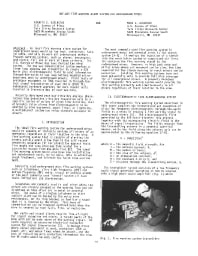Mining Publication: One-Way Fire Warning Alarm System for Underground Mines
Original creation date: July 1990
Authors: KE Hjelmstad, MA Ackerson
The Tenth WVU International Mining Electrotechnology Conference, Morgantown, West Virginia, July 24-27, 1990; :47-52
An ideal fire warning alarm system for underground mines would be low cost, convenient, fast, reliable, and able to warn all underground workers. Present warning systems, such as phones, messengers, and stench, fail one or more of these criteria. The U.S. Bureau of Mines may have devised the ideal system. The one way communication system employs a large loop antenna and transmitter to create a 630 hertz (Hz) electromagnetic field to send information through-the-earth to cap lamp battery mounted micro-receivers worn by underground miners. Field tests of prototype equipment in 1986 resulted in through-the-rock signal transmission of over 762 m (2500 ft). Subsequent hardware upgrades for more recent tests resulted in transmissions of over one mile. Recently developed receiver circuitry employs phase-locked-loop detection circuitry responsive only to a specific series of pulses of given time duration, that eliminates false alarms from electromagnetic noise emitted by mine equipment, power lines, or lightning. A multichannel system can relay standard messages to miners.

The Tenth WVU International Mining Electrotechnology Conference, Morgantown, West Virginia, July 24-27, 1990; :47-52
- Assessment of Present Electromagnetic Techniques for the Location of Trapped Miners
- Basic Tutorial on Wireless Communication and Electronic Tracking: Technology Overview
- Propagation of EM Signals in Underground Mines
- Recent National Institute for Occupational Safety and Health Research Using Ground Penetrating Radar for Detection of Mine Voids
- Refuge Alternatives in Underground Coal Mines
- The Status of Mine Fire Research in the United States
- Technology News 551 - Through-the-Earth, Post-Accident Communications - an Emerging Technology - TN-No. 551
- Through-the-Earth Communication Antenna Feasibility Demonstration
- Through-the-earth Communications Technologies Available
- Ultra-Low Frequency Through-the-Earth Communication Technology